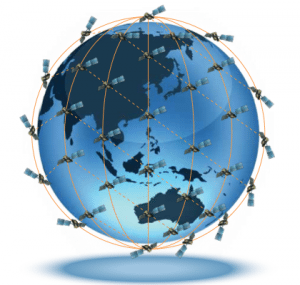Latest News

Digital rendering of Iridium NEXT constellation. Photo: Iridium
Northern Sky Research (NSR) predicts that into 2025, launch rates for Situational Awareness (SA) initiatives will grow at a 21 percent Compound Annual Growth Rate (CAGR). The satellite industry has had all eyes on the Earth Observation (EO) market on the heels of milestones such as Planet’s acquisition of Terra Bella from Google — but SA arguably deserves just as big of a spotlight, as it is a natural complement to the EO segment.
In a recent interview with Via Satellite, Planet CEO Robbie Schingler described the satellite industry as being in the midst of a “sensing revolution.” As demand for surveillance, security and efficiency continues to grow, EO data is becoming “a new utility used in our day-to-day lives,” he said. However, NSR analyst Carolyn Belle suggests in a recent report that EO data is only half of the picture, and in order to fully capitalize on the advantages of sensing technology, companies must look beyond EO imagery to more complex data applications.
Whereas EO takes a more broad approach, observing how huge swaths of the planet change over time (through analyzing weather data, for example), Belle defined SA in an interview with Via Satellite as more akin to “active monitoring.” It includes architecture such as Automatic Identification Systems (AIS) and Automatic Dependent Surveillance-Broadcasts (ADS-B), applications that have consistently grown in use and importance in verticals such as maritime and aerospace, which Belle describes as “low hanging fruit for space-based SA.”
She highlighted the proliferation of small satellites as a primary driver for the SA market, as Low Earth Orbit (LEO) constellations offer high revisit rates, significantly lower latency, and smaller capital expenditure. Furthermore, because most SA data packets are relatively small, “data rate is not a limitation to service quality as compared to other smallsat applications,” she wrote.
Fully aware of these advantages, smallsat operators have already begun preparing to provide commercial services as part of their business models. “All six commercial SA smallsat constellations will house an AIS payload for maritime, four of which will also support ADS-B for aeronautical purposes,” Belle wrote. So the competitive landscape is already beginning to feel crowded, leaving little room for non-smallsat system providers such as Orbcomm, which are also edging in on this same territory.
Last year, Orbcomm signed a partnership with Genscape that allows customers of Genscape’s Vesseltracker service to receive satellite AIS data from Orbcomm. Belle highlighted this as just one example of SA’s commercial potential, as Genscape “provides market intelligence on the energy sector by tracking vessel movements to feed supply chain models,” she said.
Aireon’s business model of providing real-time air traffic surveillance and flight tracking across the entirety of the Earth is another use case example, and also reflects the role of policymakers as this market segment grows. In November 2015, the International Civil Aviation Organization (ICAO) established a new standard forcing airline operators to track aircraft in intervals of 15 minutes by 2018. Aireon’s ADS-B network, hosted on the Iridium Next constellation, is one solution that enables airline operators to achieve that goal, as well as improve the efficiency of flight patterns regarding greenhouse gas emissions.
Belle argues that co-located payloads, such as “AISTech’s inclusion of a thermal imager in its AIS and ADS-B outfitted constellation,” could open up the addressable market for smallsat operators in particular. By layering various analytics streams in a manner similar to EO, operators can unlock new applications and thus potentially attract customers who wouldn’t normally turn to satellite data for their needs. “For example, Synthetic Aperture Radar (SAR) images can be used to verify AIS readings of a ship location,” Belle wrote.
Companies such as HawkEye 360 are also breaking new ground by pushing for detection of more varied Radio Frequency (RF) signals. HawkEye 360 plans to deploy a constellation of LEO smallsats less than 600 km from the surface, and hopes customers will leverage its fleet to monitor transportation networks, improve rescue response times by detecting activated emergency beacons, and study RF spectrum use to identify areas of interference. The company plans to tackle a wide breadth of spectrum, a strategy that will likely pay off because, as Belle writes, “operators seeking to specialize in a given data type … will be challenged to find efficiencies and appeal to a broad customer base.”
Like many emerging technologies, Belle pointed out that SA is driven largely by government and military applications for now, with the Coast Guard being one early adopter to monitor suspicious activity such as illegal fishing, she said. Still, a lot of revenue potential remains untapped here, which is why a number of early-to-market operators are hustling to bring the commercial side up to par.
Get the latest Via Satellite news!
Subscribe Now